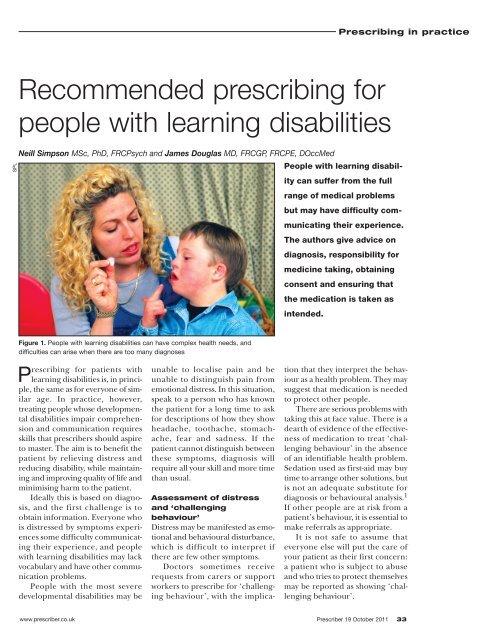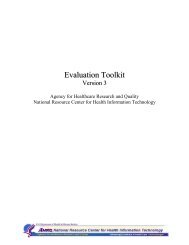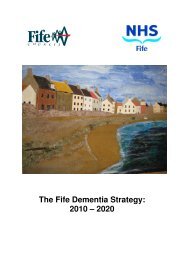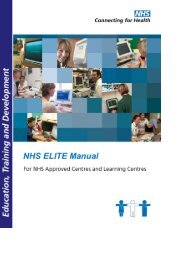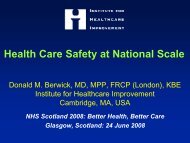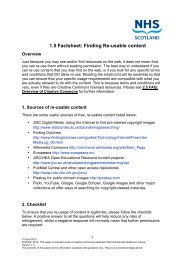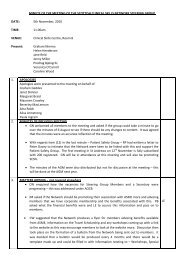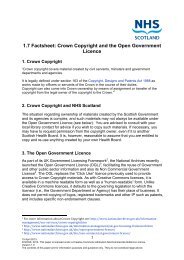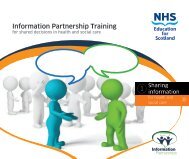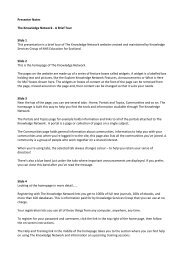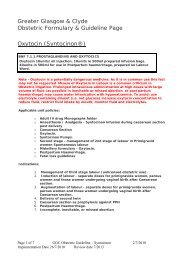Article on prescribing in Learning Disability - The Knowledge Network
Article on prescribing in Learning Disability - The Knowledge Network
Article on prescribing in Learning Disability - The Knowledge Network
You also want an ePaper? Increase the reach of your titles
YUMPU automatically turns print PDFs into web optimized ePapers that Google loves.
Prescrib<strong>in</strong>g <strong>in</strong> practice<br />
SPL<br />
Recommended <strong>prescrib<strong>in</strong>g</strong> for<br />
people with learn<strong>in</strong>g disabilities<br />
Neill Simps<strong>on</strong> MSc, PhD, FRCPsych and James Douglas MD, FRCGP, FRCPE, DOccMed<br />
People with learn<strong>in</strong>g disability<br />
can suffer from the full<br />
range of medical problems<br />
but may have difficulty communicat<strong>in</strong>g<br />
their experience.<br />
<strong>The</strong> authors give advice <strong>on</strong><br />
diagnosis, resp<strong>on</strong>sibility for<br />
medic<strong>in</strong>e tak<strong>in</strong>g, obta<strong>in</strong><strong>in</strong>g<br />
c<strong>on</strong>sent and ensur<strong>in</strong>g that<br />
the medicati<strong>on</strong> is taken as<br />
<strong>in</strong>tended.<br />
Figure 1. People with learn<strong>in</strong>g disabilities can have complex health needs, and<br />
difficulties can arise when there are too many diagnoses<br />
Prescrib<strong>in</strong>g for patients with<br />
learn<strong>in</strong>g disabilities is, <strong>in</strong> pr<strong>in</strong>ciple,<br />
the same as for every<strong>on</strong>e of similar<br />
age. In practice, however,<br />
treat<strong>in</strong>g people whose developmental<br />
disabilities impair comprehensi<strong>on</strong><br />
and communicati<strong>on</strong> requires<br />
skills that prescribers should aspire<br />
to master. <strong>The</strong> aim is to benefit the<br />
patient by reliev<strong>in</strong>g distress and<br />
reduc<strong>in</strong>g disability, while ma<strong>in</strong>ta<strong>in</strong><strong>in</strong>g<br />
and improv<strong>in</strong>g quality of life and<br />
m<strong>in</strong>imis<strong>in</strong>g harm to the patient.<br />
Ideally this is based <strong>on</strong> diagnosis,<br />
and the first challenge is to<br />
obta<strong>in</strong> <strong>in</strong>formati<strong>on</strong>. Every<strong>on</strong>e who<br />
is distressed by symptoms experiences<br />
some difficulty communicat<strong>in</strong>g<br />
their experience, and people<br />
with learn<strong>in</strong>g disabilities may lack<br />
vocabulary and have other communicati<strong>on</strong><br />
problems.<br />
People with the most severe<br />
developmental disabilities may be<br />
unable to localise pa<strong>in</strong> and be<br />
unable to dist<strong>in</strong>guish pa<strong>in</strong> from<br />
emoti<strong>on</strong>al distress. In this situati<strong>on</strong>,<br />
speak to a pers<strong>on</strong> who has known<br />
the patient for a l<strong>on</strong>g time to ask<br />
for descripti<strong>on</strong>s of how they show<br />
headache, toothache, stomachache,<br />
fear and sadness. If the<br />
patient cannot dist<strong>in</strong>guish between<br />
these symptoms, diagnosis will<br />
require all your skill and more time<br />
than usual.<br />
Assessment of distress<br />
and ‘challeng<strong>in</strong>g<br />
behaviour’<br />
Distress may be manifested as emoti<strong>on</strong>al<br />
and behavioural disturbance,<br />
which is difficult to <strong>in</strong>terpret if<br />
there are few other symptoms.<br />
Doctors sometimes receive<br />
requests from carers or support<br />
workers to prescribe for ‘challeng<strong>in</strong>g<br />
behaviour’, with the implicati<strong>on</strong><br />
that they <strong>in</strong>terpret the behaviour<br />
as a health problem. <strong>The</strong>y may<br />
suggest that medicati<strong>on</strong> is needed<br />
to protect other people.<br />
<strong>The</strong>re are serious problems with<br />
tak<strong>in</strong>g this at face value. <strong>The</strong>re is a<br />
dearth of evidence of the effectiveness<br />
of medicati<strong>on</strong> to treat ‘challeng<strong>in</strong>g<br />
behaviour’ <strong>in</strong> the absence<br />
of an identifiable health problem.<br />
Sedati<strong>on</strong> used as first-aid may buy<br />
time to arrange other soluti<strong>on</strong>s, but<br />
is not an adequate substitute for<br />
diagnosis or behavioural analysis. 1<br />
If other people are at risk from a<br />
patient’s behaviour, it is essential to<br />
make referrals as appropriate.<br />
It is not safe to assume that<br />
every<strong>on</strong>e else will put the care of<br />
your patient as their first c<strong>on</strong>cern:<br />
a patient who is subject to abuse<br />
and who tries to protect themselves<br />
may be reported as show<strong>in</strong>g ‘challeng<strong>in</strong>g<br />
behaviour’.<br />
www.prescriber.co.uk Prescriber 19 October 2011 33
Prescrib<strong>in</strong>g <strong>in</strong> practice<br />
Diagnostic uncerta<strong>in</strong>ty<br />
Be aware of the problem of ‘diagnostic<br />
overshadow<strong>in</strong>g’, whereby the<br />
co-existence of a developmental<br />
disorder causes doctors to discount<br />
relevant available <strong>in</strong>formati<strong>on</strong>.<br />
For people with communicati<strong>on</strong><br />
problems it may be difficult to reduce<br />
the diagnostic opti<strong>on</strong>s. Nevertheless,<br />
th<strong>in</strong>k about what is most likely for the<br />
pers<strong>on</strong>. For example:<br />
• Is psychosis more likely than anxiety?<br />
Not unless the pers<strong>on</strong> has previously<br />
diagnosed episodes of<br />
psychosis. If choice of treatment were<br />
based <strong>on</strong> likelihood, antipsychotic<br />
drugs would rarely be prescribed.<br />
• Is depressi<strong>on</strong> more likely than<br />
headache? Informati<strong>on</strong> about the<br />
time-course may assist, because<br />
depressi<strong>on</strong> often shows diurnal<br />
variati<strong>on</strong>.<br />
People with developmental disabilities<br />
may have complex health<br />
needs (see Table 2). <strong>The</strong> prevalence<br />
of epilepsy is greatly <strong>in</strong>creased <strong>in</strong> people<br />
with more severe cognitive impairments,<br />
and psychiatric disorders are<br />
also more frequent. People with<br />
Down’s syndrome have <strong>in</strong>cre ased frequency<br />
of several c<strong>on</strong>diti<strong>on</strong>s such as<br />
thyroid disorders and deafness.<br />
Before <strong>prescrib<strong>in</strong>g</strong>, c<strong>on</strong>sider<br />
whether there are particular po<strong>in</strong>ts<br />
<strong>in</strong> this patient’s physiology and past<br />
medical history that need to be<br />
c<strong>on</strong>sidered.<br />
Safe <strong>prescrib<strong>in</strong>g</strong> for people with<br />
learn<strong>in</strong>g disabilities should be c<strong>on</strong>venti<strong>on</strong>al,<br />
c<strong>on</strong>servative, cautious<br />
and based <strong>on</strong> at least a provisi<strong>on</strong>al<br />
diagnosis.
Prescrib<strong>in</strong>g <strong>in</strong> practice<br />
C<strong>on</strong>sider how the<br />
prescripti<strong>on</strong> may be used<br />
or misused<br />
Medicati<strong>on</strong> bel<strong>on</strong>gs to the pers<strong>on</strong><br />
for whom it is dispensed, but for<br />
people who have impaired decisi<strong>on</strong>-mak<strong>in</strong>g<br />
capacity it is frequently<br />
c<strong>on</strong>trolled by others.<br />
Authorisati<strong>on</strong> for this should be<br />
<strong>in</strong>cluded <strong>in</strong> the certificate of <strong>in</strong>capacity.<br />
Ask yourself who might ga<strong>in</strong><br />
access to these drugs and might<br />
exploit the pers<strong>on</strong> with learn<strong>in</strong>g<br />
disability.<br />
Also, always c<strong>on</strong>sider what you<br />
may have to do to protect the h<strong>on</strong>est<br />
carer <strong>in</strong> these circumstances.<br />
Suggest methods of record<strong>in</strong>g medicati<strong>on</strong><br />
given if no system is already<br />
<strong>in</strong> place <strong>in</strong> order to avoid false accusati<strong>on</strong>.<br />
Temporary and <strong>in</strong>termittent<br />
(‘first-aid’,<br />
‘rescue’ and ‘as required’)<br />
<strong>prescrib<strong>in</strong>g</strong><br />
For some cl<strong>in</strong>ical problems it is<br />
appropriate for patients to adjust<br />
the dose accord<strong>in</strong>g to the severity<br />
of symptoms, and doctors give<br />
advice to patients about how to do<br />
this. If the medicati<strong>on</strong> is c<strong>on</strong>trolled<br />
by another pers<strong>on</strong> (for example, if<br />
the patient lacks decisi<strong>on</strong>-mak<strong>in</strong>g<br />
capacity), then the questi<strong>on</strong> arises<br />
of who decides that the drug<br />
should be given or omitted? <strong>The</strong>re<br />
is unlikely to be a qualified nurse<br />
present to assess the need <strong>on</strong> each<br />
occasi<strong>on</strong>.<br />
In this situati<strong>on</strong>, it is often helpful<br />
to ask a Community Learn<strong>in</strong>g
Prescrib<strong>in</strong>g <strong>in</strong> practice<br />
Whatever the demands to prescribe ‘for behaviour’, the doctor’s task is<br />
always to treat the patient with<strong>in</strong> a framework of medical ethics. <strong>The</strong> ethical<br />
basis for <strong>prescrib<strong>in</strong>g</strong> is to put the care of your patient as your first c<strong>on</strong>cern, not<br />
the protecti<strong>on</strong> of others (although there may be sec<strong>on</strong>dary benefits to others).<br />
Record your justificati<strong>on</strong> <strong>in</strong> the notes. Remember:<br />
• first do no harm<br />
• try and do good<br />
• preserve aut<strong>on</strong>omy of the patient wherever possible<br />
• c<strong>on</strong>sider justice for all your patients and your resp<strong>on</strong>sibility to use resources<br />
fairly<br />
Table 1. Ethical framework for <strong>prescrib<strong>in</strong>g</strong><br />
<strong>Disability</strong> Nurse and pharmacist to<br />
help you write a care plan describ<strong>in</strong>g<br />
the cl<strong>in</strong>ical features that should<br />
determ<strong>in</strong>e whether or not the drug<br />
is given. Templates for treatment<br />
plans and protocols are available,<br />
and an example of <strong>on</strong>e for rescue<br />
medicati<strong>on</strong> for epilepsy is available<br />
with the NHS Scotland Epilepsy<br />
toolbox. 3<br />
Remember to <strong>in</strong>clude the use of<br />
the protocol <strong>in</strong> the certificate of<br />
<strong>in</strong>capacity to authorise treatment if<br />
required. <strong>The</strong> protocol should<br />
<strong>in</strong>clude a descripti<strong>on</strong> of how the<br />
plan is to be m<strong>on</strong>itored and<br />
reviewed.<br />
C<strong>on</strong>sent<br />
Obta<strong>in</strong> c<strong>on</strong>sent if possible. <strong>The</strong>re<br />
are three comp<strong>on</strong>ents to c<strong>on</strong>sent:<br />
<strong>in</strong>formati<strong>on</strong> about the opti<strong>on</strong>s and<br />
their c<strong>on</strong>sequences; decisi<strong>on</strong>-mak<strong>in</strong>g<br />
capacity; and aut<strong>on</strong>omy of decisi<strong>on</strong>-mak<strong>in</strong>g<br />
(see Table 4). People<br />
with learn<strong>in</strong>g disabilities may be at<br />
a disadvantage with each of these.<br />
Prescribers must c<strong>on</strong>sider how best<br />
to ensure that the pers<strong>on</strong> has been<br />
given <strong>in</strong>formati<strong>on</strong> – it is not always<br />
best to do it quickly at the end of a<br />
diagnostic c<strong>on</strong>sultati<strong>on</strong>. Record<br />
what you have d<strong>on</strong>e and what you<br />
have asked others to do.<br />
After sign<strong>in</strong>g the<br />
prescripti<strong>on</strong><br />
For the medicati<strong>on</strong> to be used as<br />
<strong>in</strong>tended requires that a pharmacist<br />
receives and dispenses the prescripti<strong>on</strong>,<br />
the patient or a<br />
resp<strong>on</strong>sible carer stores the medicati<strong>on</strong><br />
correctly, and the patient<br />
remembers (or is prompted) to<br />
take the medicati<strong>on</strong> at the times<br />
and dosage <strong>in</strong>tended.<br />
<strong>The</strong>se tasks do not require a<br />
doctor to carry them out if there is<br />
teamwork. <strong>The</strong> patient, the pharmacist<br />
and carers have roles, and<br />
may need advice and support to<br />
achieve these tasks.<br />
<strong>The</strong>re are <strong>prescrib<strong>in</strong>g</strong> decisi<strong>on</strong>s<br />
that can make these tasks easier:<br />
• c<strong>on</strong>sider weekly dispens<strong>in</strong>g packs<br />
from the pharmacy<br />
• limit the amounts dispensed to<br />
avoid stockpiles<br />
• align the amounts dispensed of<br />
each item <strong>on</strong> your computer to the<br />
same time period, eg 28 days to fit<br />
with orig<strong>in</strong>al pack dispens<strong>in</strong>g<br />
• try to avoid dosage regimens that<br />
require assistance from services<br />
• low weight, eg when <strong>prescrib<strong>in</strong>g</strong><br />
paracetamol<br />
• low eGFR<br />
• immunocompromised<br />
• previous GI bleed<strong>in</strong>g<br />
• low seizure threshold<br />
• abnormal liver functi<strong>on</strong> tests<br />
• diabetes<br />
• previous gout<br />
• abnormal BMI<br />
• PEG feed<strong>in</strong>g<br />
• difficulty swallow<strong>in</strong>g tablets<br />
• cardiac arrhythmias<br />
• prol<strong>on</strong>ged QT symptoms<br />
• potential for br<strong>on</strong>chospasm<br />
Table 2. Examples of pre-exist<strong>in</strong>g<br />
problems that should make you cautious<br />
when <strong>prescrib<strong>in</strong>g</strong><br />
away from the patient’s home, such<br />
as day centres.<br />
Th<strong>in</strong>k ahead to next time<br />
Diagnostic problems are sometimes<br />
solved by further enquiry or <strong>in</strong>vestigati<strong>on</strong>s,<br />
but sometimes not. When<br />
the problem recurs, you will be<br />
n<strong>on</strong>e the wiser unless you make a<br />
provisi<strong>on</strong>al diagnosis.<br />
Sometimes the difficulty is that<br />
the patient has too many diagnoses<br />
(eg pre-exist<strong>in</strong>g learn<strong>in</strong>g disability,<br />
autism, epilepsy and anxiety state)<br />
or has a rare disorder (eg Angelman<br />
syndrome, Tourette’s syndrome).<br />
C<strong>on</strong>sider <strong>in</strong>volv<strong>in</strong>g the local<br />
Learn<strong>in</strong>g <strong>Disability</strong> Team to c<strong>on</strong>tribute<br />
to the assessment.<br />
A crisis of emoti<strong>on</strong>al and behavioural<br />
disturbance may benefit from<br />
a first-aid prescripti<strong>on</strong> (eg us<strong>in</strong>g a<br />
benzodiazep<strong>in</strong>e for anxiety), but<br />
what should you do if the under ly<strong>in</strong>g<br />
problem persists and the request to<br />
Forum<br />
If you have any issues you would like to air with your colleagues or comments <strong>on</strong> articles published<br />
<strong>in</strong> Prescriber, the Editor would be pleased to receive them and, if appropriate, publish them <strong>on</strong> our<br />
Forum page. Please send your comments to: <strong>The</strong> Editor, Prescriber, <strong>The</strong> Atrium, Southern Gate,<br />
Chichester, West Sussex PO19 8SQ, or e-mail to prescriber@wiley.com<br />
36 Prescriber 19 October 2011 www.prescriber.co.uk
Prescrib<strong>in</strong>g <strong>in</strong> practice<br />
• Have you c<strong>on</strong>sidered benefits and risks with the patient to the limit of their<br />
understand<strong>in</strong>g <strong>in</strong> your c<strong>on</strong>sultati<strong>on</strong>?<br />
• Have you c<strong>on</strong>sidered and negotiated the more complex risk analysis for that<br />
particular drug or new comb<strong>in</strong>ati<strong>on</strong> with the carer or family member <strong>in</strong> the<br />
c<strong>on</strong>sultati<strong>on</strong>?<br />
• What are the potential drug <strong>in</strong>teracti<strong>on</strong>s and iatrogenic symptoms that might<br />
be difficult to pick up <strong>in</strong> the future unless c<strong>on</strong>sidered <strong>in</strong> advance with patient<br />
and carer?<br />
• Are you <strong>prescrib<strong>in</strong>g</strong> a drug with addictive potential or street resale value?<br />
benzodiazep<strong>in</strong>es, eg diazepam, temazepam<br />
str<strong>on</strong>g opiates, eg morph<strong>in</strong>e, pethid<strong>in</strong>e, fentanyl<br />
moderate opiates, eg tramadol, dihydrocode<strong>in</strong>e<br />
weak opioids, eg code<strong>in</strong>e<br />
Table 3. Balance of benefits and risks<br />
prescribe becomes l<strong>on</strong>g term, or if<br />
the carers do not follow your advice?<br />
Suggest arrang<strong>in</strong>g a review date, and<br />
if the drug cannot be withdrawn<br />
<strong>in</strong>volve the local Learn<strong>in</strong>g <strong>Disability</strong><br />
Team to advise about alternative<br />
treatment approaches.<br />
Social care workers and the<br />
organisati<strong>on</strong>s that employ them<br />
(care providers) sometimes have difficulty<br />
understand<strong>in</strong>g the requirements<br />
for safe use of medic<strong>in</strong>es, and<br />
they may have procedures that are<br />
<strong>in</strong>tended to benefit and protect<br />
their clients but that have not been<br />
negotiated with prescribers. <strong>The</strong>re<br />
has been some progress towards<br />
improvement through tra<strong>in</strong><strong>in</strong>g. 4<br />
C<strong>on</strong>clusi<strong>on</strong><br />
Try to avoid assumpti<strong>on</strong>s and generalisati<strong>on</strong>s<br />
about people with<br />
learn<strong>in</strong>g disabilities. <strong>The</strong>y experience<br />
the full range of medical<br />
needs, but may have difficulty<br />
communicat<strong>in</strong>g about them and<br />
may lack capacity to c<strong>on</strong>sent to<br />
treatment.<br />
Use a systematic approach and<br />
obta<strong>in</strong> advice from local specialist<br />
teams to assist you to ensure your<br />
prescripti<strong>on</strong> will be used to<br />
achieve maximum benefit for your<br />
patient.<br />
References<br />
1. Deb S, et al. Us<strong>in</strong>g medicati<strong>on</strong> to manage<br />
behavioural problems <strong>in</strong> adults with learn<strong>in</strong>g<br />
disabilities. University of Birm -<br />
<strong>in</strong>gham, 2006. www.ld-medicati<strong>on</strong>.<br />
bham.ac.uk/<strong>in</strong>dex.shtml.<br />
2. http://cl<strong>in</strong>icalevidence.bmj.com/<br />
ceweb/<strong>in</strong>dex.jsp.<br />
3. Toolbox for management of epilepsy <strong>in</strong> people<br />
with a learn<strong>in</strong>g disability. West of<br />
Scotland and Tayside Adult Epilepsy<br />
Managed Cl<strong>in</strong>ical <strong>Network</strong>. www.<br />
epilepsytoolbox.scot.nhs.uk.<br />
4. Associati<strong>on</strong> for Real Change. www.<br />
arcuk.org.uk/silo/files/76.pdf.<br />
Task Comment Suggesti<strong>on</strong>s<br />
Giv<strong>in</strong>g <strong>in</strong>formati<strong>on</strong> c<strong>on</strong>sider what will make the a leaflet for carers to expla<strong>in</strong> to the patient<br />
<strong>in</strong>formati<strong>on</strong> most readily a request to the pharmacist to expla<strong>in</strong> medicati<strong>on</strong> benefits<br />
understood<br />
and adverse effects<br />
a letter to the patient to be shared with the carer<br />
other media such as audio, DVD, Internet, text message<br />
Assess<strong>in</strong>g decisi<strong>on</strong>- remember that this is a medical ask the patient to expla<strong>in</strong> what they expect (‘what are the<br />
mak<strong>in</strong>g capacity resp<strong>on</strong>sibility that cannot be tablets for?’)<br />
delegated<br />
use the correct legal framework – AWI <strong>in</strong> Scotland, MCA <strong>in</strong><br />
England and Wales<br />
use the toolkit <strong>on</strong> the BMA website 2<br />
ask for assistance if needed; a pharmacist can give<br />
<strong>in</strong>formati<strong>on</strong>, a Community Learn<strong>in</strong>g <strong>Disability</strong> Nurse can<br />
design care plans to enable the patient to use your advice<br />
C<strong>on</strong>sider<strong>in</strong>g whether duty to protect may over-ride look for evidence that a pers<strong>on</strong> may be subject to neglect,<br />
aut<strong>on</strong>omy is <strong>in</strong>fr<strong>in</strong>ged duty of c<strong>on</strong>fidentiality exploitati<strong>on</strong> or abuse<br />
look for evidence that there is a pers<strong>on</strong> who should be<br />
expected to be <strong>in</strong> a positi<strong>on</strong> of resp<strong>on</strong>sibility with a duty of<br />
care towards the pers<strong>on</strong><br />
if c<strong>on</strong>cerns rema<strong>in</strong>, use the procedure for protecti<strong>on</strong> of<br />
vulnerable adults<br />
Table 4. Obta<strong>in</strong><strong>in</strong>g c<strong>on</strong>sent; AWI = Adults with Incapacity Act, MCA = Mental Capacity Act<br />
www.prescriber.co.uk Prescriber 19 October 2011 37
Prescrib<strong>in</strong>g <strong>in</strong> practice<br />
• Does the pers<strong>on</strong> have necessary skills to obta<strong>in</strong> and<br />
use prescripti<strong>on</strong>?<br />
– ask for support from carers, pharmacy or local<br />
Learn<strong>in</strong>g <strong>Disability</strong> Team<br />
• Does the pers<strong>on</strong> understand the advice about frequency,<br />
durati<strong>on</strong> and whether to request a repeat prescripti<strong>on</strong>?<br />
– write it down, ask for support from carers, pharmacy<br />
or local Learn<strong>in</strong>g <strong>Disability</strong> Team<br />
• Does the pers<strong>on</strong> dislike aspects of the prescripti<strong>on</strong><br />
(taste, size of tablet, colour)?<br />
– ask pharmacy to suggest alternatives or ways to<br />
m<strong>in</strong>imise the problem, or to obta<strong>in</strong> specialist pharmacy<br />
advice<br />
Table 5. Ensur<strong>in</strong>g that the medicati<strong>on</strong> is taken as <strong>in</strong>tended<br />
• formally review repeat prescripti<strong>on</strong> lists, <strong>in</strong>dicati<strong>on</strong>s, amounts and usage at<br />
least annually<br />
• c<strong>on</strong>sider us<strong>in</strong>g a Chr<strong>on</strong>ic Disease Management framework<br />
• use other c<strong>on</strong>sultati<strong>on</strong>s outside structured reviews to ma<strong>in</strong>ta<strong>in</strong> currency of<br />
<strong>prescrib<strong>in</strong>g</strong> review screens<br />
• use the appropriate <strong>prescrib<strong>in</strong>g</strong> screens and codes to record start<strong>in</strong>g, stopp<strong>in</strong>g<br />
and chang<strong>in</strong>g repeat medicati<strong>on</strong>s; accurate cod<strong>in</strong>g here will save time<br />
<strong>in</strong> future when you or somebody else is ask<strong>in</strong>g themselves why or when a<br />
particular drug was put <strong>on</strong> repeat<br />
• record drug side-effects and allergies accurately when they occur aga<strong>in</strong>st<br />
the codes and screens that appear <strong>in</strong> the highlighted summaries for the<br />
future; <strong>in</strong> particular you should remember these codes are searched for <strong>in</strong><br />
GP records to download <strong>in</strong>to emergency care summaries for out-of-hours<br />
services<br />
Table 6. M<strong>on</strong>itor<strong>in</strong>g and review<strong>in</strong>g repeat prescripti<strong>on</strong>s<br />
Declarati<strong>on</strong> of <strong>in</strong>terests<br />
Dr Simps<strong>on</strong> undertakes educati<strong>on</strong>al<br />
work <strong>in</strong> relati<strong>on</strong> to the applicati<strong>on</strong><br />
of mental health legislati<strong>on</strong><br />
for Walkgrove Limited for a fee,<br />
and c<strong>on</strong>sultancy work overseas for<br />
the World Health Organizati<strong>on</strong> for<br />
an h<strong>on</strong>orarium; Dr Douglas, n<strong>on</strong>e<br />
declared.<br />
Dr Simps<strong>on</strong> is a c<strong>on</strong>sultant <strong>in</strong> learn<strong>in</strong>g<br />
disability psychiatry and associate<br />
medical director for Learn<strong>in</strong>g<br />
<strong>Disability</strong> <strong>in</strong> NHS Greater Glasgow<br />
and Clyde, and Dr Douglas is a general<br />
practiti<strong>on</strong>er at Tweeddale<br />
Medical Practice, Fort William,<br />
Scotland<br />
38 Prescriber 19 October 2011 www.prescriber.co.uk


